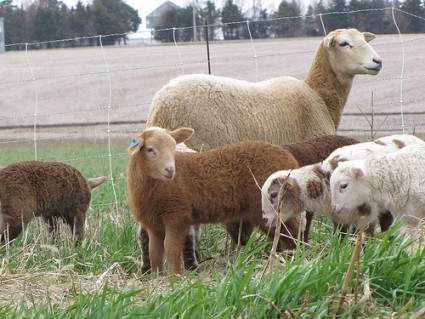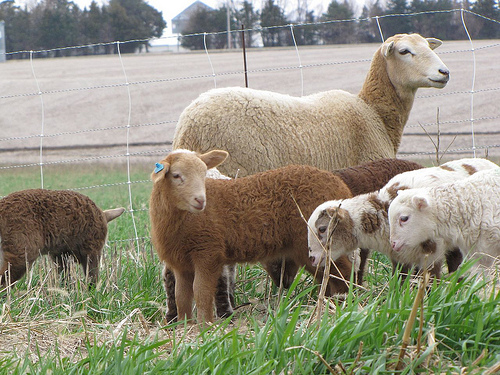 Someone to watch over me: a mama ewe, with lambs. Photo: Steph LarsenWhen I get home tonight, eleven adorable newborns will greet me with their wide eyes and cute faces. Overseeing the care of so many is a daunting task, but luckily I have help: their mamas. Spring means lambs on Thistle Root Farm, and for the last few weeks our time has been spent caring for pregnant sheep, watching for the signs of impending birth, and making sure the new babies get off to the best possible start.
Someone to watch over me: a mama ewe, with lambs. Photo: Steph LarsenWhen I get home tonight, eleven adorable newborns will greet me with their wide eyes and cute faces. Overseeing the care of so many is a daunting task, but luckily I have help: their mamas. Spring means lambs on Thistle Root Farm, and for the last few weeks our time has been spent caring for pregnant sheep, watching for the signs of impending birth, and making sure the new babies get off to the best possible start.
At times, it’s not been easy. There’s an old shepherd joke that says the first thing a lamb does when it’s born is look for a place to die. With six ewes done and three to go, we haven’t lost any lambs yet, and I hope it stays that way.
This is our first year lambing, and so far I’ve mostly learned the many things that can go wrong with newborn lambs. When a cold front hit one night, I spent the next morning in the barn with my hair dryer, warming up the twins born around 4am. Another lamb was born completely within its water sac, and might have drowned had we not been right there to break it open. We took turns getting up in the middle of the night to check for new arrivals, and like new parents everywhere I was starting to get a little sleep deprived.
Katahdin sheep are known to be good mothers, and it’s amazing to me how they all know exactly what to do. When a lamb is born, their mama immediately begins to lick them clean. After a few minutes the lamb starts trying its legs out, and within 20 minutes a good mama has guided her lamb to a teat, filling its belly with high calorie, antibody-rich collostrum. If not, we step in to guide them. There’s a special trick to coaxing a stubborn lamb to eat for the first time, and my partner, Brian, has a knack for it that I haven’t quite mastered yet.
Like human pregnancies, there can be complications. One of the ewes had a health problem that required careful monitoring, a special diet, sutures and an uncomfortable harness to keep everything in the right place. Eventually we had to induce labor, coincidentally with a similar drug to the one used on humans. She gave birth in the back of the pick-up, just in case we had to take her back to the vet. We bought all the children’s ibuprofen at the grocery store because it was easier to administer to her than pills. I doubt we’re the first people to think of that.
We haven’t had a breech birth yet, but we’ve got plastic gloves and “personal lubricant” in case we need to reach in and assist. The giant book of medical advice for shepherds gives me detailed information on what to do in every possible incorrect birth position, and since it’s from a British publisher I get to read words like “whilst.” There are many sections in that book I hope I never use.
The flock can be a handful to manage, but it’s all worth it when I can relax in the pasture and watch everyone play.



